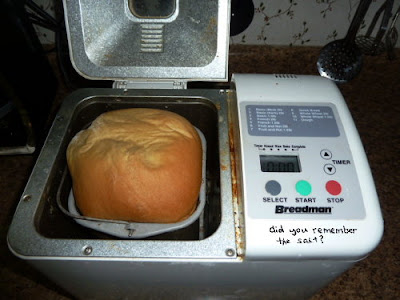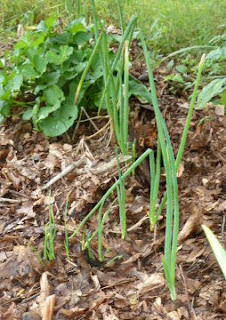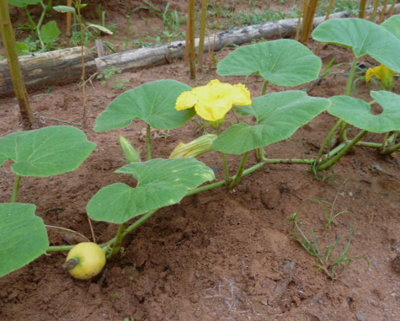 |
| Photo taken from the path between the garden and the house |
In the background, you may be able to make out the field corn, drying on the stalk. It will be ready to harvest soon. In front of that are the cowpeas. These too are beginning to die back, though they are still producing like crazy. On the front right, is where we planted our winter wheat last autumn.
 |
| Photo of our wheat field last January |
We harvested about half of the wheat we planted. What you see in that top photo, was the section left unharvested. So much of it had lodged (flattened), and was overgrown with weeds, that it was near impossible to scythe. I said, 'let's just leave it and see what happens. Maybe the straw will create a natural mulch and the wheat berries will reseed the area in a new growth of wheat'. Now it looks like this...
 |
| Same field, now overgrown with weeds and no wheat in sight |
One of the things we're concerned with, is whether or not our five acres is manageable. I'm gradually coming to realize however, that our idea of manageability carries with it a certain mindset about the way things ought to be. Our concept of well managed includes looking like we've got things under control. A near half acre full of weeds, like this one, looks out of control. That isn't part of the definition.
 |
| Better view of the corn and cowpeas |
Last year after we harvested the corn, we turned the goats and chickens into the field. They feasted! On the corn plants and especially on the "weeds." I had honestly never seen our Nubians look so fat. And healthy. There's a truth here, that often seems to be overlooked, that goats are naturally foragers. Because of that they are often recommended for brush control. Goats thrive on "browse," i.e. weeds, and shrubs, and bark, and leaves; all the things that don't belong in a well managed pasture or grain field. But beyond using scrub goats to eliminate brush, management techniques for modern goat keeping revolve around pasture, hay, and "concentrates" or grain. The problem is, these aren't the things they thrive on. In fact, it seems that folks on the goat forums are constantly discussing health issues related to diet and mineral deficiencies.
In Homestead Master Plan, 2012 Revision, I mentioned what we were thinking about, in terms of rotating field crops, animals, and pasture/ forage areas. That came about because of this very field. It had been neglected for so many years before we bought the place, that sapling trees and perennial vines were well established. It has been a battle to try and grow anything here because of that. Since we don't have heavy duty plowing and cultivating equipment, it makes more sense to partner with animals to do the job for us. It's a win-win, because goats are healthier on weeds, the chickens help with the seeds, and the pigs (coming this spring) will root out and feast on the roots as well as the weeds. Indeed, they will fertilize and till the soil for planting.
All of this is important, because if we are going to raise all our own animal feeds, then it makes more sense to utilize an animal's natural diet, rather than try to replicate a homemade version of a commercial feed system. Our weeds are a ready resource for that natural diet, even in their hay. This is why our goats deem the pretty, pure grass, boughten hay merely okay, but fight over the weedy hay we harvest from our own pasture.
 |
| Dan scything the pasture, May of 2010 |
Weeds will grow. They will take over a garden, a yard, a pasture, and field crops. What we've been needing, is not a way to conquer them as weeds, but a new way of looking at it. They aren't unsightly unwanteds, they are valuable, nutritious forage. There are a few I have to be on the lookout for and eradicate, those poisonous to goats, but all the rest are a valuable resource. And right under our very noses.
Them Ain't Weeds, Them's Forage photos & text ©
Sept. 2012 by Leigh at http://my5acredream.blogspot.com/
Sept. 2012 by Leigh at http://my5acredream.blogspot.com/










































